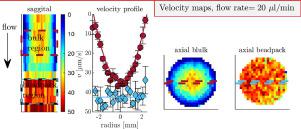Journal of Magnetic Resonance Open ( IF 1.5 ) Pub Date : 2020-07-22 , DOI: 10.1016/j.jmro.2020.100004 Nathan H. Williamson , Michal E. Komlosh , Dan Benjamini , Peter J. Basser

|
Pulsed gradient spin echo (PGSE) complex signal behavior becomes dominated by attenuation rather than oscillation when displacements due to flow are similar or less than diffusive displacements. In this “slow-flow” regime, the optimal displacement encoding parameter q for phase contrast velocimetry depends on the diffusive length scale rather than the velocity encoding parameter . The minimum detectable mean velocity using the difference between the phase at and is . These theories are then validated and applied to MRI by performing PGSE echo planar imaging experiments on water flowing through a column with a bulk region and a beadpack region at controlled flow rates. Velocities as slow as 6 μm/s are detected with velocimetry. Theories, MRI experimental protocols, and validation on a controlled phantom help to bridge the gap between porous media NMR and pre-clinical phase contrast and diffusion MRI.
中文翻译:

相衬MRI中流量检测的局限性
当由于流动引起的位移与扩散位移相似或小于扩散位移时,脉冲梯度自旋回波(PGSE)复合信号的行为将由衰减而不是振荡决定。在这种“慢流”状态下,用于相位对比测速的最佳位移编码参数q取决于扩散长度范围 而不是速度编码参数 。最小可检测平均速度,使用相之间的差 和 是 。然后,通过对以可控流速流经具有大体积区域和珠状填料区域的色谱柱的水进行PGSE回波平面成像实验,可以验证这些理论并将其应用于MRI。速度慢至6 μ米/秒与测速检测。理论,MRI实验方案以及在可控模型上的验证有助于弥合多孔介质NMR与临床前相衬和扩散MRI之间的差距。











































 京公网安备 11010802027423号
京公网安备 11010802027423号